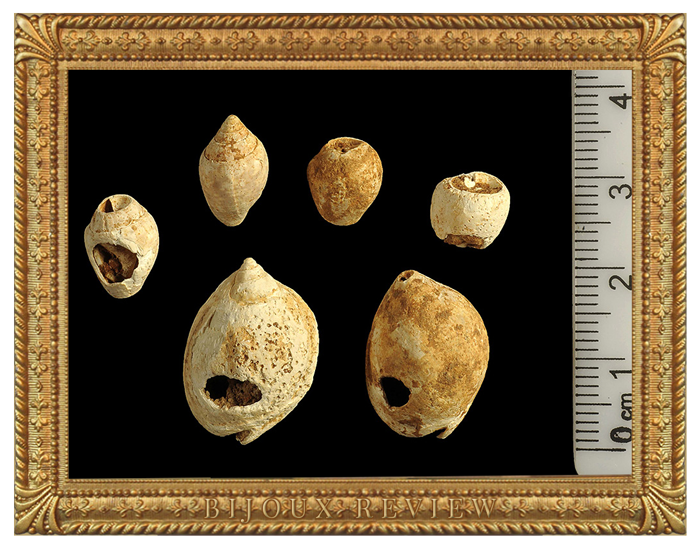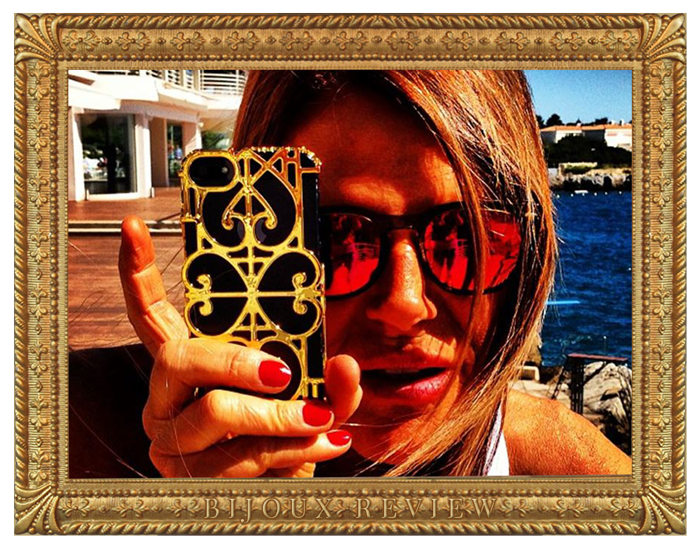
Photo by K. Amit. Frame courtesy of EKDuncan.
Global fashion tastemaker Anna Dello Russo (www.annadellorusso.com) has long maintained that fashion and jewelry transcend mere ornamentation to serve as powerfully persuasive, symbolic communication.
Bijoux Review is thrilled to report that archaeological research indicates bead-making kickstarted symbolic thinking in humans.
Yes, you read that correctly.
Bead-making, perhaps the world’s most ancient jewelry fabrication technique, kickstarted a critically important phase in the evolution of human consciousness!
What’s more, according to research and dating of ancient seashells, our species has been making bling for 100,000 years…or more.
Proof positive that Anna Dello Russo’s oracular utterances about the semiotics of human adornment have been right all along. Way to go, Anna!
Now for the science behind this story: Earth’s earliest known jewelry was excavated in the 1930s and 1940s from two places: Mount Carmel in Israel, and Oued Djebbana, Algeria. It took until 2006, however, for scientists to study these shells and formulate estimated dates for them.
As it happened, Marian Vanhaeren from University College London and her colleagues found the shells while investigating museum collections at the Natural History Museum in London and the Museum of Man in Paris.
The scientists say that the shells contain holes that are likely to have been human-made. (Then again, it’s possible that ancient jewelry lovers purposely chose to wear shells that had holes in them.)
Intriguingly, the Algerian seashell beads were found far from the sea.
“Oued Djebbana is almost 200 kilometers (125 miles) from the sea, which means these shells were certainly taken by humans and brought to the site,” said Francesco d’Errico of the Centre National de la Recherche Scientifique in Talence, France, a co-author of the study that was published in the June 23, 2006 issue of Science.
Radiocarbon dating of the Algerian site indicates that a shell found there could be up to 90,000 years old, based on the technology and style of stone tools found in the ground.
By chemically matching sediment samples from a shell exterior and a human bone from the Israeli site, Vanhaeren and colleagues dated the Israeli shell as being anywhere from 100,000 to 135,000 years old.
Until the Algerian and Israeli shells were studied, the earliest evidence of sophisticated human behavior, including use of specialized tools and personal adornment, came from 40,000-year-old sites in Europe.
Tools and jewelry found at these places gave rise to the theory that a sudden creative explosion took place among ancient humans around 45,000 years ago, possibly due to changes within the brain.
The analysis and dating of the Israeli shells, however, supports the theory that “modern” human behavior emerged gradually. Note: Just as fashion historians argue whether Coco Chanel or Paul Poiret is more responsible for originating “modern” fashion, the scientific debate rages over what constitutes “modern” behavior.
Scientists do agree on this crucial point: ancient bead making is evidence of early symbolic thinking.
Clear connections between bead-creation and symbolic thinking exist, they say, because making beads has zero to do with basic human needs such as food, shelter and out-maneuvering predators. Ditto bead-making for trade purposes.
How cool is it that the beginning of bead-making signifies a huge step forward in human development?
With basic survival needs covered, our ancestors were free to focus on culturally important things, like nature’s blingy seashells.
It appears that humans started wearing jewelry 90,000 to 100,000 years ago to satisfy newly emerging human needs, including:
The need to differentiate ourselves materially from others through ornamentation.
The need to communicate oneness with the natural world through wearing gems on our bodies.
The need to create jewelry for jewelry’s sake.
The need to express tribal identity and social status (contemporary examples of this include prisoners of Hermes Collier de Chien belts; hand cuffs and of course, Cartier LOVE bracelets).
Here’s the fashion part of this story, as embodied by Anna Dello Russo, a.k.a. AdR.
Famous for wearing straight-from-the-runway fashion and bling-tastic jewels, she’s a supernova in the street style blogosphere. AdR’s Instagram account has 644,676 (count ’em!) followers.

Photo by AdR on Instagram. Frame courtesy of EKDuncan.
The editor-at-large of VOGUE Nippon and a brilliantly baroque blogger, AdR is also a jewelry and accessories designer whose 2012 collection for global high street retailer H & M sold out feverishly fast. AdR’s designs for H & M, as well as her personal jewelry collection, evince a connoisseur’s eye for fine jewels and watches from the 19th, 20th and 21st centuries.
AdR’s H & M jewels, bejeweled eyewear and clutches all succeed in conjuring fantastic personae. Her golden and green enamel alligator necklaces and massive gold and turquoise pieces for the line glow with the glam energy of 40s movie stars and sizzle with carefree, sunny sensuality. When she’s wearing other designers, such as Dolce & Gabbana’s en tremblant coin earrings or Byzantine-inspired costume jewels, AdR’s alive with historically informed, hyper-Italian sophistication that looks as ornate as it does relaxed. It’s fun to watch AdR playfully communicate the power of paradox through the jewelry she designs and the jewelry of other designers who she favors.
Accessorizing designer outfits with 18k yellow gold jeweled giant-link chains by Faraone Mennella or 18k yellow gold Bulgari Serpenti watches, her renegade elegance also pays respect to rappers in the form of giant golden padlock necklaces and heavily stoned bling.
While AdR’s collection for H & M qualifies as an aesthetic and commercial triumph, we think she deserves a more materially de luxe platform for her design talent to shine as brightly as she deserves.
Bijoux Review prophesies that a house of haute joaillerie will make human history’s next great leap in symbolic thinking and hire AdR to design a collection in noble metals and precious gems. Time to wake up, Bulgari and Buccellati!
Place Vendome jewelers, on your marks, get set, go!
Boucheron, are you ready?
How about you, Van Cleef and Arpels?
Perhaps la maison de Chaumet will come to their senses and commission AdR to design some high jewelry?
Until then, here’s what you can do to adorn yourself and help advance human symbolic behavior:
1) buy seashell motif jewelry from AERIN (www.aerin.com) and wear it
2) share your knowledge of 100,000 year-old jewelry and how bead-making helped birth symbolic thinking
3) make some of your own jewelry to trigger a new evolutionary phase in your behavior
4) go to annadellarusso.com and plug into AdR’s fashion/jewelry consciousness
5) check out Dante 5, the exuberantly chic boutique in Bari, Italy that AdR co-owns with her childhood friend Alessandra
6) Read More on ancient jewelry @ http://news.nationalgeographic.com/news/2006/06/060622-jewelry_2.html
